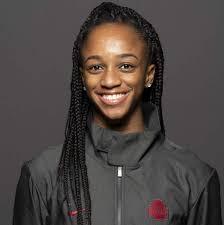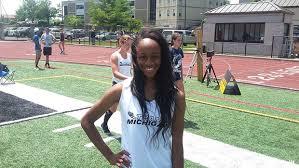David Hunter wrote this piece on the amazing Anavia Battle and her promise, now an in the future. Will she continue to race faster and faster and contibute to her teams’ big wins?
Dave Hunter thinks so. That is part of the reason you see this feature! Watch the end of the NCAA indoor season and let us know how you think she is progressing. Dave Hunter captures the essence of the coach athlete relationship.
 Anavia Battle, photo by Ohio State Buckeyes
Anavia Battle, photo by Ohio State Buckeyes
March 5th, 2019
Collegiate track & field coaches and those who follow our sport closely will tell you that the performance levels of the very best high school athletes on the track and in the field have recently progressed at an impressive rate. Better advancements in training, nutrition, weight work, event technique, shoes, equipment, and athlete commitment have combined to produce year-after-year bumper crops of top flight prep athletes heading to college. But not all of these athletes prove able to continue the impressive trajectory of progression they authored as preps. For collegiate coaches, the challenge is to properly evaluate this high school talent: to look for strengths; to spot weaknesses; to assess attitudes and commitment, and hope they can arrive at the correct conclusions about which athletes can thrive in the competitive world of collegiate track & field.
One such athlete who assembled impressive – but not mind-blowing – credentials as a high schooler is Ohio State University sprinter Anavia Battle. While a prep at Wayne Memorial in Inskter, Michigan, Battle displayed steady progression and in her senior year captured the 2017 Michigan state 100 meter crown in 11.95 and was the Junior Olympic champion in both the 100m and 200m. The diminutive sprinter and her successes on the oval drew attention. But did she have the potential for continued improvement and championship level success at a Power 5 university? Ohio State University Head Coach Karen Dennis believed she did. “When I first watched Anavia compete, I thought to myself ‘This little girl has great mechanics and a very fluid sprinting style,'” explains Dennis who has a particular eye for identifying sprinters, hurdlers, and jumpers with top flight collegiate potential. The positive impressions Battle had during her recruiting visit to OSU was more than enough for this sprinter from the Wolverine State to take her talents to Columbus.
As a freshman, Battle continued to improve, winning the bronze in both the 60m [7.42] and the 200m [23.24] at the 2018 Big Ten indoor championships. Outdoors, she was the 100m champion at both the Jesse Owens Track Classic and the Drake Relays. At the Big Ten outdoor championships, the young sprinter showed further progression, running a personal best 11.47 in the 100m and a career best 22.94 to capture the silver in the 200m.
After an undercover season which saw the Michigan native break the Ohio State indoor record for the women’s 200m [23.00], Battle came into this year’s Big Ten indoor championship meet with the league-leading marks in both the 60m and the 200m. In the 60 meter final Battle finished 2nd after being nipped at the line by Nebraska senior Lakayla Harris whose 7.26 clocking replaced Battle’s earlier Big Ten leading mark of 7:32. Composed after the loss, Battle undoubtedly had to be disappointed. “Oh, she was hot,” confides Coach Dennis. But, as good athletes do, the OSU dash star found a way to channel that disappointment in a positive way an hour later in the 200 meter final. With an explosive start and nimble speed around Michigan’s new state-of-the-art banked indoor track, Battle buried the other finalists, crossing the line in 22.80 for a whopping .57 second margin over the runner-up: Iowa’s Briana Guillory. How impressive was Anavia Battle’s winning PR time? Her clocking set a new Michigan indoor track facility record, set new marks for both the Big Ten Conference and Championship records, broke the existing Ohio State indoor record, and established new collegiate, American, and World leaders for this indoor season.
Afterwards, the Big Ten 200m champion was delighted, but not surprised by, her championship victory and record-setting time. “I knew what I was capable of walking into it. My coach [OSU assistant coach Joel Brown] and I had been talking about breaking 23 earlier this season. So I was actually very happy.” In addition to preparing Battle physically and honing her sprint mechanics, Brown – a 3-time All-American hurdler while at Ohio State and the 2005 national indoor hurdles champion and world championship hurdles finalist – helps Battle with the mental aspects of the sport, embedding within his sprint protégé a pre-race regimen calculated to calm her mind and center her spirit before she heads out onto the track. “Before I run, I get really nervous,” admits Battle. “But with the help of Coach Joel, he calms me down. He helps me breathe slowly and get my mind right so I can run without being nervous.” Battle knows that cultivating that pre-race serenity is an essential ingredient for performance at the highest level. “Nervous can do a toll on you. It can make or break you.” The world leader knows that Coach Brown has the magic touch to send her to the starting line in the right frame of mind just before the threshold of competition. “He normally sends me off with ‘Go have fun,'” reveals a smiling Battle. “And I’m like, ‘Okay.'”.
Watching the diminutive sprinter in action evokes memories of 4-time Olympic gold medalist Evelyn Ashford, a petite sprint champion unknown to Battle. Unencumbered by a larger frame, Battle, in competition, appears able to transition through the start, the drive phase, and into upright sprinting more efficiently than her larger competitors. “I think that is because of the force I apply off the blocks – it really helps me coming off the blocks and into the curve. Also, I’ve gotten stronger with my starts this year. We’re really focusing on that this year,” states Battle. With Dennis and Brown continuing to polish her mechanics and sprint technique, Battle is excited about further progression – especially once she get back outside and onto the larger oval. “I think the 200 will always be my bread and butter. Last year, my PR was 22.94 and to run 22.80 inside it was just really surprising.”
Anavia Battle and Karen Dennis share a very positive and healthy athlete/coach relationship. And that bond is further strengthened by a very special and rather rare connection. While a collegiate track athlete at Michigan State and competing in the 1975 AIAW national championships, the young Karen Dennis was the victor in the 220 yard dash final. And now Coach Dennis hopes to guide her young protégé to a furlong national championship win of her own. “Oh, we talk about it all the time,” offers Battle matter-of-factly. “And we talked about it in the last few days. She asked me, ‘What’s your favorite part of the 200?’ and I told her coming off the curve. And she paused for a moment and said, ‘That’s my favorite.’ She always reminds me before I get out on his track how to run the 200 right, that I’ve got this, and to just stay calm and just do what I do best – that’s running.”
Coach Dennis, who serves as Ohio State’s Director for both the men’s and women’s programs in track & field and cross country, once suspected and now knows she has a special athlete in Battle. As a former collegiate sprint stand-out in the mid-70’s, Dennis knows her sophomore sprint star brings the right attitude to practice every day. “She has a good work ethic,” notes Dennis, who has piloted the Buckeyes to a number of Big Ten team titles during her 15 year tenure in Columbus, including each of OSU’s 3 women’s indoor team titles. “She’s what I like to a call a blue-collar athlete. She comes to practice every day with the right attitude and is ready to work.”
Goal-setting is an important preliminary element of achievement. And “going public” – articulating the goal to others – strengthens the goal-seeker’s commitment. And Anavia Battle is quite clear:, “I want to win Nationals. I want to be the national champion. That is the goal.” Battle will have the opportunity to achieve the goal she shares with her coach this weekend in Birmingham. It is an opportunity she relishes. .”Before nationals we will be training Monday through Friday, probably executing a few things on Saturday, rest on Sunday, then before we leave for nationals we’ll probably do a few things in the weight room – nothing too heavy, nothing too much – and some technique work. And then I think we’ll be ready.” And after a pause, she adds, “I know we’ll be ready.”
 Anavia Battle, photo courtesy of Michigan Mile Split
Anavia Battle, photo courtesy of Michigan Mile Split
Coach Dennis senses her sophomore sprint star is ready to deliver a top flight 200 meter performance at the NCAA indoor championships “Anavia has a strong will, good internal motivation. She wants to be exceptional. And she has now shown she belongs in that class.” Just like her world leading athlete, Coach Dennis is excited to witness Battle perform on collegiate track’s biggest stage. “This will be a good test for her. She wants to be the national champion,” adds Dennis echoing Battle’s declaration. And if Anavia Battle would win the NCAA indoor 200 meter crown, it would of course be another impressive step forward for the young sprinter. And it would also provide further affirmation that two years ago the Ohio State coaching staff correctly evaluated her prospects for collegiate success. / Dave Hunter /
Author

Dave Hunter is an award-winning journalist who is a U.S. Correspondent for Track & Field News. He also writes a weekly column and serves as Senior Writer for www.RunBlogRun.com, and covers championship track & field competition domestically and in such global capitals as Moscow, Birmingham, Zurich, Brussels, Beijing, Rio de Janeiro, Zagreb, Ostrava, and Doha. Hunter frequently serves as the arena or stadium announcer for championship track & field gatherings, including the Ivy League, the Big East, the Mid-American Conference, the NAIA, the Big Ten, and the Millrose Games. Hunter has undertaken foreign and domestic broadcast assignments. He ran his marathon P.R. 2:31:40 on the Boston Marathon course back in the Paleozoic Era. To find out more about Dave, visit his website: www.trackandfieldhunter.com He can be reached at: dave@trackandfieldhunter.com
View all posts




















